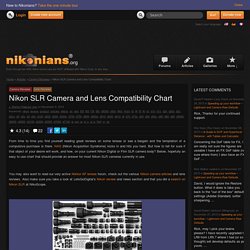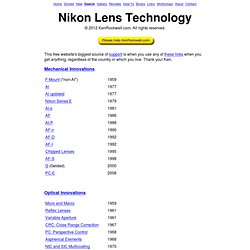

Through the Nikon F-Mount - using older lenses on your Nikon DSLR. Using older lenses on your Nikon DSLR January 1, 2012 Updated, see below.

You want to buy an older - meaning manual focus without CPU - lens for your Nikon DSLR (or newer SLR)? First of all you should have a look at the manual of your camera body. Make sure that the lens you are interested in is not on the list of incompatible lenses or serial numbers. If it is a lens without an automatic diaphragm (e. g. a "Reflex-Nikkor" or a shift lens / PC-Nikkor) you can use it.
For an automatic lens you have to have a closer look at the aperture ring. Do not use non-AI lenses! In 1977 Nikon made an important change in the way the camera gets the aperture value from the lens. The old lenses were usable without any modification in conjunction with the new AI cameras in stop down metering. But even cameras without AI coupling (with CPU interface only, e. g. Nikon itself offered the modifying of old lenses as a service, where the original aperture ring was replaced by an AI type ring.
Nikon SLR Camera and Lens Compatibility. From time to time you find yourself reading great reviews on some lenses or see a bargain and the temptation of a compulsive purchase is there.

NAS (Nikon Acquisition Syndrome) kicks in and hits you hard. But how to tell for sure if that object of your desire will work, and how, on your current Nikon Digital or Film SLR camera body? Below, hopefully an easy to use chart that should provide an answer for most Nikon SLR cameras currently in use. You may also want to read our very active Nikkor AF lenses forum, check out the various Nikon camera articles and lens reviews. Also make sure you take a look at LetsGoDigital's Nikon review and news section and that you did a search on Nikon SLR at NikoScope. Compatibility Table. What is the difference between an AI lens, an AI-S lens, and Non-AI lens? In 1977 Nikon introduced a new system for coupling the lens to the cameras exposure system.

This new coupling system was called "Automatic maximum aperture indexing" or "Ai" for short. This change did not effect the traditional Nikon bayonet mount, thus allowing Ai (and the latter AF and AIS) lenses to be fitted to older non-Ai cameras. However, while Ai lenses where backwards compatible with non-Ai cameras, non Ai lenses where not compatible with all Ai cameras.
The Nikon FM, FE, EL2, F3, F4 and Nikkormat FT3 cameras used the Ai metering system but allowed non-Ai lenses to be fitted due to the metering coupling lever being able to be disengaged. The F5 can have this mechanism fitted as an optional extra, please contact your local Nikon representive for more details. Nikkor Lens Technology. This free website's biggest source of support is when you use any of these links when you get anything, regardless of the country in which you live.

Thank you! Ken. Mechanical Innovations Optical Innovations Nikon Lens Compatibility 23 September 2007 Nikon System Compatibility 05 September 2007 August 2012 Nikon Reviews Nikon Lenses All Reviews Introduction Nikon is the leader when it comes to compatibility among cameras and lenses of different decades. The key is to understand Nikon's alphabet soup. The only two gotchas in 50 years have been in 1986, when AF lenses lost the prong needed to couple to pre-1977 cameras.
Some Nikon designations are mechanical, like F, AI, and AF; while others are optical, like ED and IF. Mechanical History F (also called pre-AI and non-AI): 1959 top Nikon Nikkor-H 50mm f/2. Non-AI, Pre-AI (also called NAI) refers to the original Nikon F bayonet lens mount and lenses introduced in 1959 for the Nikon F camera.
You can recognize these first lenses from: 1.) 1.) 2.)